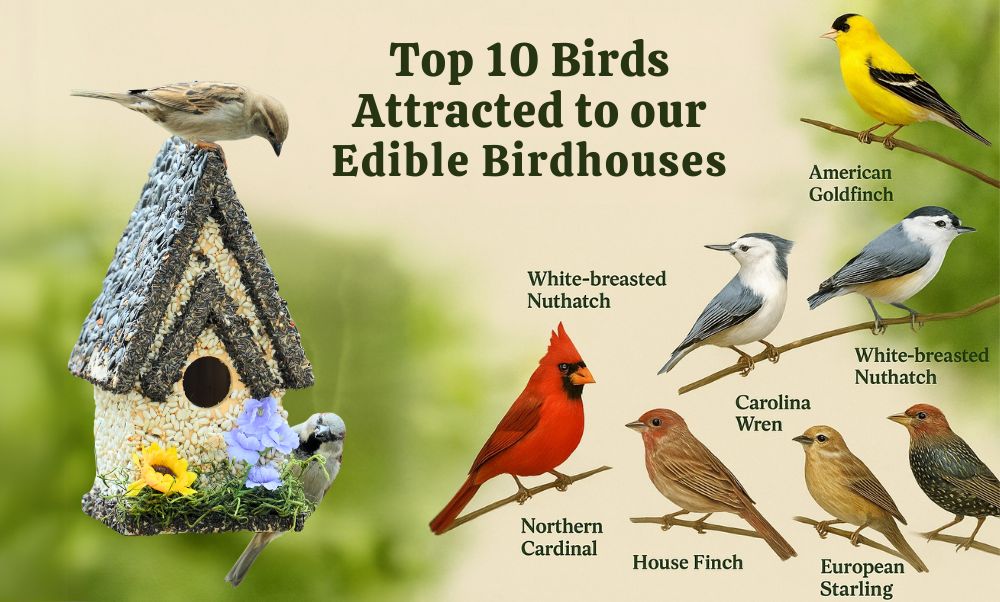
Top 10 Backyard Birds You Can Attract with an Edible Birdhouse
Share
It has never been easier to bring the wonders of nature into your own yard. An edible birdhouse allows you to provide a safe and nutritious haven for feathered guests while admiring their beauty. Because they are covered in nutrient-dense bird seeds, these handmade birdhouses are the perfect combination of birdhouse and bird feeder in one unique design.
Whether you are a serious birdwatcher or simply like watching songbirds pass across your yard, investing in a seeded birdhouse is an excellent way to attract a diverse range of species. Using Hidden Creek's beautiful, USA-made designs, let's look at the top ten backyard birds that can be attracted with a birdhouse filled with bird seed.
American Goldfinch
American Goldfinches are frequent visitors to backyard bird feeder houses, recognized for their vivid yellow hue and cheerful noises. These birds enjoy black oil sunflower seeds and Nyjer (thistle), which we carefully selected for our seed mix.
- Why they visit: Nyjer and sunflower seeds are their favorites.
- Gold finches are the only finches in North America that molt twice a year.
- Meet More Feathered Friends
Northern Cardinal
The Northern Cardinal, one of North America's most recognizable birds, enjoys the birdseed birdhouse because it contains cracked corn and black oil sunflower seeds.
- Why they visit: They enjoy perching on wide surfaces while they feed.
- Fun Fact: Both male and female cardinals sing, and their tunes vary by region.
- Pro Tip: Cardinals appreciate quiet, shrub-filled areas. Pair their visit with a bird feeding house nearby.
White-Breasted Nuthatch
The White-Breasted Nuthatch is an agile and curious bird that is frequently spotted climbing up and down tree trunks. They'll enthusiastically explore a birdhouse filled with bird seed, especially if it contains black oil sunflower seeds and cracked corn.
- Why they visit: They love sticking their beaks into crevices on the house to extract seeds.
- Fun Fact: They can walk headfirst down tree trunks!
Black Capped Chickadee
Curious by nature, The Black-Capped Chickadee is a small bird that visits the birdhouse bird feeder which contains sunflower seeds and millet.
- Why they visit: They’ll snack and even use the house as shelter.
- Fun Fact: They can hide seeds in hundreds of spots—and remember each one!
- See What Seeds They Love
Carolina Wren
Carolina Wrens are energetic and melodic, adding vitality to any garden. They appreciate bird houses made of millet and cracked corn.
- Why they visit: They’re cavity nesters and may use your house for shelter.
- Fun Fact: They sing year-round—even in winter!
- Tip: Keep your birdhouse feeder near shrubs or woodpiles for best results.
House Finch
House Finches are gregarious birds that feed in swarms and are distinguished by their reddish coloring and cheerful chirps. We provide millet, milo, and sunflower seeds in our edible bird feeders to cater to their preferences.
- Why they visit: They treat the house like a social spot.
- Fun Fact: The redder the male, the better his diet!
House Sparrow
House Sparrows are here to stay, whether you love them or hate them. They thrive around people and flock to bird houses stuffed with millet, cracked corn, and milo.
- Why they visit: They’ll even nest inside if the space suits them.
- Fun Fact: They chirp all day and love living in colonies.
European Starling
These shimmering birds are known for their mimicry skills. European Starlings are attracted to birdhouses stocked with milo and cracked corn.
- Why they visit: They’re opportunists looking for easy food sources.
- Fun Fact: They can mimic alarms, other birds, and even human speech!
Tufted Titmouse (Honorable Mention)
Though not listed on the Edible Birdhouses page, these tiny, grey songbirds are often seen enjoying our handmade birdhouses. They particularly like sunflower seeds.
- Why they visit: The birdhouse provides safety and snacks.
- Tip: Offer fresh water nearby for extra attraction.
Squirrels (Not Birds, But Worth Mentioning)
Although not a bird, squirrels can be a nuisance to your bird house covered with bird seed. Thankfully, Edible Birdhouses are blended with habanero and chili pepper flakes—a bird-safe but squirrel-repelling solution.
- Why they avoid it: The spice keeps them at bay without harming birds.
- Fun Fact: Birds can't taste capsaicin, but squirrels sure can.
How to Maximize Bird Visits
Want to turn your backyard into a bird paradise? Here's how:
- Location Matters: Hang your edible birdhouse in a semi-sheltered spot, away from foot traffic.
- Stay Chemical-Free: Avoid using pesticides or sprays near the birdhouse feeder.
- Provide Water: A birdbath or shallow water dish nearby makes your yard even more attractive.
- Re-Seed Regularly: Our edible birdhouse is easy to refresh with peanut butter and fresh seeds. See our How to
Why Choose Edible Birdhouses?
Crafted by hand in Pennsylvania, our birdhouses blend beauty and function. Made with care and built to last, each edible birdhouse includes:
- A DIY wooden base for long-term use.
- Natural Spanish moss for comfortable nesting.
- A 5-year guarantee on the structure.
- Easy re-seeding instructions to keep the birds coming back.
They’re perfect for nature lovers, gift-givers, and anyone wanting to purchase bird houses and feeders that give back to nature.
Conclusion
The edible bird houses by Hidden Creek provide a considerate, eco-friendly way to appreciate nature, whether you're looking to buy bird houses as gifts or adorn your backyard with them. You'll be amazed at the variety of life that can be attracted to a single birdhouse covered in bird seeds, from Northern Cardinals and Black-Capped Chickadees to many more.
For a full list of the birds that love our homes, check out the Types of Birds page. Curious about our seed blends? Explore our Types of Seeds guide for even more insight.
Ready to bring nature to your doorstep? Choose Hidden Creek’s handcrafted, edible birdhouses and enjoy birdwatching like never before.
